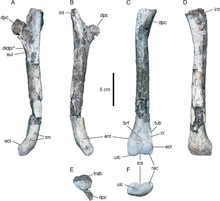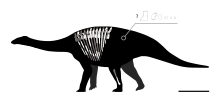

|
|
|
||
| Line 793: | Line 793: | ||
| |
| |
||
|- |
|- |
||
| ''[[Phalcrocorax bakonyiensis]]''{{cite journal|author1=Horváth, I.|author2=Futó, J.|author3=Kessler, J.|year=2024|title=''Phalacrocorax bakonyiensis'’ n. sp., a new species of cormorant from the Late Miocene of Hungary|journal=Ornis Hungarica|volume=32|pages=222–230|doi=10.2478/orhu-2024-0016}}</ref> |
| ''[[Phalcrocorax bakonyiensis]]''<ref>{{cite journal|author1=Horváth, I.|author2=Futó, J.|author3=Kessler, J.|year=2024|title=''Phalacrocorax bakonyiensis'’ n. sp., a new species of cormorant from the Late Miocene of Hungary|journal=Ornis Hungarica|volume=32|pages=222–230|doi=10.2478/orhu-2024-0016}}</ref> |
||
| Sp. nov |
| Sp. nov |
||
| Valid |
| Valid |
||
| |||
|---|---|---|---|
|
| |||
| |||
|
|
This article records new taxa of every kind of fossil archosaur that are scheduled to be described during 2024, as well as other significant discoveries and events related to the paleontology of archosaurs that will be published in 2024.
| Name | Novelty | Status | Authors | Age | Type locality | Country | Notes | Images |
|---|---|---|---|---|---|---|---|---|
|
Sp. nov |
In press |
Martins et al. |
Late Cretaceous |
Abaurusuchid. Announced in 2023; the final article version was published in 2024. |
||||
|
Sp. nov |
Narváez et al. |
Eocene (Lutetian) |
Abasal member of Crocodyloidea. |
|||||
|
Sp. nov |
Iori et al. |
Late Cretaceous |
||||||
|
Gen. et sp. nov |
Valid |
Reyes, Martz & Small |
Late Triassic (Norian) |
Anaetosaur. The type species is G. muelleri. |
||||
|
Gen. et sp. nov |
Valid |
López-Rojas et al. |
Late Jurassic (Kimmeridgian-Tithonian) |
Agoniopholidid crocodylomorph. The type species is O. paimogonectes. |
||||
|
Gen. et comb. nov |
Desojo & Rauhut |
Triassic (Ladinian-Carnian) |
Pinheiros-Chiniquá Sequence of the Santa Maria Supersequence |
A member of Paracrocodylomorpha, probably belonging to the group Poposauroidea. The type species is "Prestosuchus" loricatus von Huene (1938). |
||||
|
Gen et sp. nov |
In press |
Pochat-Cottilloux et al. |
Early Cretaceous |
Anatoposaurid. The type species is V. sakonnakhonensis. |
| Name | Novelty | Status | Authors | Age | Type locality | Country | Notes | Images |
|---|---|---|---|---|---|---|---|---|
|
Gen. et sp. nov |
Alvarez Nogueira et al. |
Late Cretaceous (Cenomanian-Turonian) |
Anelasmarian ornithopod. The type species is C. nekul. |

| ||||
|
Gen. et sp. nov |
Valid |
Xing et al. |
Late Cretaceous (Turonian-Early Coniacian) |
Anankylosaurid. The type species is D. yingliangis. |

| |||
|
Gen. et sp. nov |
Valid |
Porfiri et al. |
Late Cretaceous (Santonian) |
Aunenlagiine theropod. The type species is D. lechiguanae. |

| |||
|
Gen. et sp. nov |
Valid |
Baron |
Early Jurassic (Hettangian–Sinemurian) |
Anaverostran theropod. The type species is D. normani. |

| |||
|
Gen. et sp. nov |
Atkins-Weltman et al. |
Late Cretaceous (Maastrichtian) |
Acaenagnathid theropod. The type species is E. infernalis. |

| ||||
|
Gen. et sp. nov |
Valid |
Han et al. |
Late Cretaceous (Cenomanian-Turonian) |
Zhoutian Formation |
A titanosaur sauropod. The type species is G. cavocaudatus. |

| ||
|
Gen. et sp. nov |
Valid |
Rotatori et al. |
Late Jurassic |
An early diverging iguanodontian ornithopod, possibly a dryomorphan. The type species is H. martinhotomasorum. |
||||
|
Gen. et sp. nov |
Valid |
Filippi et al. |
Late Cretaceous (Santonian) |
A titanosaur sauropod. The type species is I. oslatus. Announced in 2023; the final article version was published in 2024. |

| |||
|
Gen. et sp. nov |
Ren et al. |
Late Jurassic |
Amamenchisaurid sauropod. The type species is J. dongxingensis. The initially proposed name is preoccupied by Jingia Chen, 1983.[37] The replacement name was published in an addendum.[38] |

| ||||
|
Gen. et sp. nov |
Averianov et al. |
Early Cretaceous (Aptian) |
Anoasaurid theropod. The type species is K. longipes. |
|||||
| Koleken[40] | Gen. et sp. nov | Pol et al. | Late Cretaceous (Campanian-Maastrichtian) | La Colonia Formation | Anabelisaurid theropod. The type species is K. inakayali. | |||
|
Gen. et sp. nov |
Longrich et al. |
Late Cretaceous (Maastrichtian) |
Alambeosaurine hadrosaurid belonging to the tribe Arenysaurini. The type species is M. bata. |

| ||||
| Musankwa[42] | Gen. et sp. nov | Barrett et al. | Late Triassic (Norian) | Pebbly Arkose Formation | Amassopodan sauropodomorph. The type species is M. sanyatiensis. | 
| ||
|
Gen. et sp. nov |
Isasmendi et al. |
Early Cretaceous (Barremian-Aptian) |
Aspinosaurid theropod. The type species is R. lacustris. |

| ||||
|
Gen. et sp. nov |
Valid |
Lerzo et al. |
Late Cretaceous (Cenomanian-Turonian) |
Arebbachisaurid sauropod. The type species is S. marae. |

| |||
|
Gen. et sp. nov |
Zafaty et al. |
Middle Jurassic |
Astegosaurian. The type species is T. atlasicus. |

| ||||
|
Gen. et sp. nov |
Pereira et al. |
Cretaceous (Albian–Cenomanian) |
Abasal titanosaur sauropod. The type species is T. valdecii. |

| ||||
| Tietasaura[47] | Gen. et sp. nov | Bandeira et al. | Early Cretaceous (Valanginian–Hauterivian) | Marfim Formation | An elasmarian ornithopod. The type species is T. derbyiana. | 
| ||
|
Gen. et sp. nov |
Pérez-Moreno et al. |
Late Cretaceous (Campanian-Maastrichtian) |
A titanosaur sauropod. The type species is T. gimenezi. |
|||||
|
Sp. nov |
Valid |
Dalman et al. |
Late Cretaceous (Campanian-Maastrichtian) |
Atyrannosaurine; a species of Tyrannosaurus. |
||||
|
Gen. et sp. nov |
In press |
Soto et al. |
Late Cretaceous |
A titanosaur sauropod belonging to the group Saltasauroidea. The type species is U. celeste. |

| |||
|
Gen. et sp. nov |
Valid |
Longrich et al. |
Early Cretaceous (Barremian) |
Ahypsilophodontid. The type species is V. insularis. Announced in 2023; the final article version was published in 2024. |
||||
|
Gen. et sp. nov |
Valid |
Jia et al. |
Early Cretaceous (Albian) |
A stegosaurian. The type species is Y. ultimus. |

|
| Name | Novelty | Status | Authors | Age | Type locality | Country | Notes | Images |
|---|---|---|---|---|---|---|---|---|
|
Sp. nov |
Valid |
Tennyson et al. |
A species of Ardenna. |
|||||
|
Gen. et sp. et comb. nov |
Valid |
Zelenkov |
Pliocene and Pleistocene |
Crimea |
A relative of the grey partridge. The type species is E. voinstvenskyi; genus also includes "Phasianus" etuliensis Bocheński & Kurochkin (1987) from Moldova. |
|||
| Eocypselus geminus[138] | Sp. nov | In press | Mayr & Kitchener | Eocene | London Clay | A species of Eocypselus. | ||
| Eocypselus grandissimus[138] | Sp. nov | In press | Mayr & Kitchener | Eocene | London Clay | A species of Eocypselus. | ||
| Eocypselus paulomajor[138] | Sp. nov | In press | Mayr & Kitchener | Eocene | London Clay | A species of Eocypselus. | ||
| Fluvioviridavis michaeldanielsi[139] | Sp. nov | Mayr & Kitchener | Eocene | London Clay | A species of Fluvioviridavis. | |||
| Fluvioviridavis nazensis[139] | Sp. nov | Mayr & Kitchener | Eocene | London Clay | A species of Fluvioviridavis. | |||
|
Gen. et sp. nov |
In press |
Wang et al. |
Anenantiornithine. The type species is I. attenboroughi. |
|||||
|
Gen. et comb. nov |
Valid |
Zelenkov |
Pliocene and Pleistocene |
A grouse; a new genus for "Lagopus lagopus" atavus Jánossy (1974), originally described from the Rębielice Królewskie 1 locality in Poland, subsequently also described from the Taurida Cave in Crimea.[141] |
||||
| Phalcrocorax bakonyiensis[142] | Sp. nov | Valid | Horváth, Futó, & Kessler | Miocene | Acormorant; a species of Phalacrocorax. | |||
|
Gen. et 2 sp. et comb. nov |
Valid |
Mayr & Kitchener |
Eocene |
London Clay |
A possible member of Piciformes. The type species is P. minor; genus also includes new species P. major, as well as "Neanis" kistneri Feduccia (1973). |
|||
|
Sp. nov |
Valid |
Mayr & Kitchener |
Eocene (Ypresian) |
London Clay |
Astem group roller belonging or related to the family Primobucconidae. |
|||
|
Gen. et sp. nov |
Valid |
Mayr & Kitchener |
Eocene (Ypresian) |
London Clay |
A member of Upupiformes. The type species is W. tendringensis. |
|||
|
Gen. et comb. nov |
In press |
De Mendoza, Degrange & Tambussi |
A member of Anseriformes of uncertain affinites; a new genus for "Telmabates" howardae. |
| Name | Novelty | Status | Authors | Age | Type locality | Country | Notes | Images |
|---|---|---|---|---|---|---|---|---|
| Ceoptera[179] | Gen. et sp. nov | Valid | Martin-Silverstone et al. | Middle Jurassic | Kilmaluag Formation | Adarwinopteran. The type species is C. evansae. | ||
|
Gen. et sp. nov |
Valid |
Pentland et al. |
Early Cretaceous (Albian) |
A member of Anhangueria. The type species is H. peterseni. |
||||
| Torukjara[181] | Gen. et sp. nov | Valid | Pêgas | Early Cretaceous | Caiuá Group | Atapejarid. The type species is T. bandeirae. |
{{cite journal}}: CS1 maint: bibcode (link)